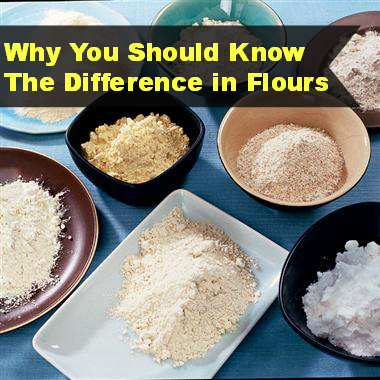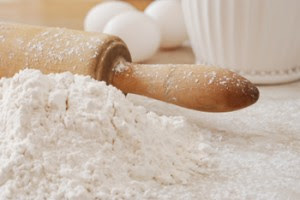When I was younger, even just a couple of years ago, or really, maybe few months ago, I could have cared less about what different flours meant. I would use all purpose flour for everything, even if it called for something else. What was the difference? Well I guess there is a difference, and I need to know the differences. Especially when I want my baked goods to taste right, or have the knowledge that some flours have less gluten or are healthier. You may be like me and not think there is a difference, but I think one day you will, and this list will help you when you are ready to expand your horizons when it comes to the right kind of flours.
ALL-PURPOSE FLOUR
All-purpose flour is a mixture of high and low gluten protein flours, formulated to make a consistent baked good for the most diverse amount of recipes. While other flours may be more specifically suited to a particular recipe, AP flour can usually be used interchangeably when other flours are called for in a recipe.
BREAD FLOUR
Bread flour is made exclusively from hard, high protein wheat. The additional protein and gluten content give a baked good more structure when combined with a volatile ingredient, such as yeast in basic bread.
CAKE FLOUR
Cake flour is made from soft wheat and has the lowest gluten content of any wheat flour. This allows the flour to be lighter, especially when matched with a high sugar recipe. The lightness allows the cakes to keep a risen and fluffy texture without collapsing.
PASTRY FLOUR
Pastry flour is made from soft wheat. Its gluten content falls somewhere between cake flour and all purpose flour. It is not readily available in stores, but can be mimicked using a 2-1 ratio of all purpose to cake flour. Best uses for Pastry Flour include pie crust, biscuits, brownies, cookies, and quick breads. Pastry flour should not be used for yeast breads.
SELF-RISING FLOUR
Self rising flour is typically all purpose flour with salt and baking powder (a leavening, i.e. rising agent) added to it. You can make your own, or buy it in the store. To make your own, for every one cup of flour, add 1 1/2 tsp of baking powder and 1/2 tsp of salt. Stir with a whisk to make sure it is evenly distributed. Self rising flour is used for biscuits and quick breads most often.
WHOLE WHEAT FLOUR
Whole wheat flour is made from the whole kernel of wheat. Typically it is higher in fiber and nutrient content than any other wheat flour. The gluten level of whole wheat flour is mid-range, so it is usually combined with other flours in baked goods for stability and texture.
STORING FLOUR
Flour is best stored in the freezer or in air tight containers. It will keep for up to a year in air tight containers, and possibly longer in the freezer. It is recommended to remove the flour from the paper bag it is shipped in and transfer it to another container upon purchase.
Gluten-free
CORNMEAL
Made from corn in coarse, medium and fine mills, and used to make polenta, it also adds its sunny yellow color to quick breads raised with bicarbonate of soda or baking powder. Another one to mix with wheat flours for yeasted breads. Coarse yellow-brown Mexican masa harina for tortillas is made from corn, too.
CORNFLOUR AND ARROWROOT
Cornflour is finely ground flour from corn, and arrowroot is from the root of the arrowroot plant. Both are used for thickening rather than baking, but arrowroot has the advantage in that it doesn’t cloud the sauce.
BUCKWHEAT
Sounds like a grain, but there’s no wheat here, just seeds. The roasted seeds can be served like rice and the grey-brown, rather bitter and earthy flour made into spaghetti, blinis



Leave a Reply